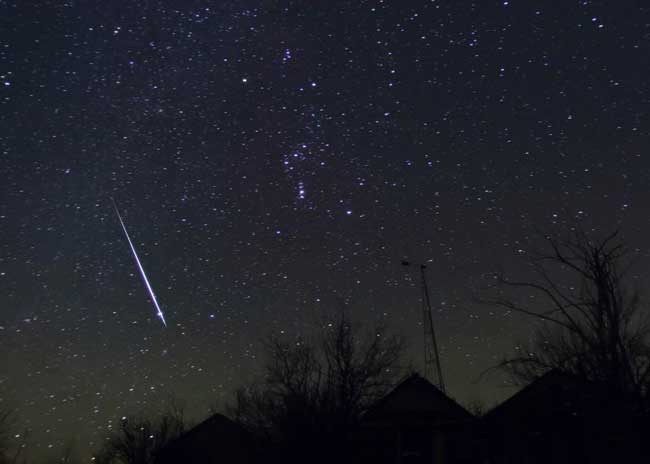Best Meteor Shower of 2009 Peaks Tonight

This year's annual Geminid meteor shower is expected to be a doozie, producing up to 140 "shooting stars" per hour.
The event, which NASA has labeled the best meteor shower of 2009, has been ramping up the past few days but gets serious tonight.
Maximum activity is expected early Monday – around 12:10 a.m. EST (0510 UT). But the peak of this event encompasses several hours, astronomers say. So good viewing can be had from around 9 p.m. local time tonight through dawn Monday.
The best time? "Watch the sky during the hours around local midnight," advises NASA meteor expert Bill Cooke.
The Geminids will be visible to anyone in the Northern Hemisphere, weather permitting. People in suburbs and cities, where lights are bright, will not see fainter meteors and so will experience lower numbers.
How to watch
Meteor watching is easy. Just go out and look up. Telescopes and binoculars are of no use. However, some planning is in order. Seasoned skywatchers suggest:
Breaking space news, the latest updates on rocket launches, skywatching events and more!
- Dress warmly. Very warmly.
- Find a location away from porch lights and streetlights.
- Bring a blanket or lounge chair so you can lie down.
- Give your eyes 15 minutes to adjust to the darkness.
- Scan as much of the sky as possible.
The meteors can appear anywhere in the sky, but if traced back, they'll all appear to emanate from the constellation of Gemini, hence the name of the shower. Geminds may appear in bursts, so give the show some time. If you only expect to watch for an hour or less, then around midnight local time is the best time to go out.
"Depending on how dark your location is, and how much of the sky you can see, meteors may streak into view that night at an average rate of one or two per minute," said SPACE.com's Skywatching Columnist Joe Rao.
Bright future
Geminds are bits of debris left in space by a strange object called 3200 Phaethon. First thought to be an asteroid, 3200 Phaethon is now classified as a dead comet. Whatever its label, when it orbits the sun, it sheds debris that forms a stream, through which Earth passes each December. Most of the stuff is the size of a pea or smaller, and as these bits enter Earth's atmosphere, they vaporize, creating the streaks of light.
The Geminids have become more productive in recent years and even better shows are expected in the future. "The Geminids are strong – and getting stronger," Cooke said.
Why? Jupiter's gravity has been shifting Phaethon's debris stream more toward Earth's orbit, according to NASA. So each year we plunge deeper into the stream. Scientists aren't sure what the future holds, but leading computer models predict a continued increase.
"It is likely that Geminid activity will increase for the next few decades, perhaps getting 20 percent to 50 percent higher than current rates," said meteor researcher Peter Brown of the University of Western Ontario.
- Viewer's Guide: Details on the Geminids
- Meteor Shower Viewing Tips
- Meteor Shower Photography

Rob has been producing internet content since the mid-1990s. He was a writer, editor and Director of Site Operations at Space.com starting in 1999. He served as Managing Editor of LiveScience since its launch in 2004. He then oversaw news operations for the Space.com's then-parent company TechMediaNetwork's growing suite of technology, science and business news sites. Prior to joining the company, Rob was an editor at The Star-Ledger in New Jersey. He has a journalism degree from Humboldt State University in California, is an author and also writes for Medium.
